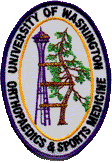
Welcome to The UW Shoulder Site @ uwshoulder.com
Please note that information on this site was NOT authored by Dr. Frederic A Matsen III and has not been proofread or intended for general public use. Information was intended for internal use only and is a compilation for random notes and resources.
If you are looking for medical information about the treatment of shoulders, please visit shoulderarthritis.blogspot.com for an index of the many blog entries by Dr. Frederick A Matsen III.
Common US Shoulder Prostheses
|
Cofield (Smith and Nephew) Prostheses
Reverse/Inverted Shoulder Systems
Odd, Uncommon, Discontinued, European Only and Experimental Systems
List of Implants and Manufactures and Distributors
|
Ever wanted to know what shoulder prosthesis you were looking at on an x-ray? Are you planning a big revision arthroplasty and need to know which vendor to call for part?
A good set of x-rays and the following images should help you identify most shoulder prostheses commonly used in the US.
1st generation prostheses (monoblock, non-modular):
Neer (3M)
Cofiels (Richards)
Fenlin (Zimmer)
2nd generation prostheses (modular):
Neer (3M)
Bio-Modular (Biomet)
Select Shoulder (intermedics Orthopedics, Inc.)
Global (DePuy)
3rd generation prostheses (modular and adaptable variable version,
offset and inclination):
Aequalis (Tornier)
Anatomical Shoulder System (Zimmer)
4th generation prostheses (modular and in situ adjustability):
Equinoxe (Exactech)
3D Univers
PROMOS modular components
Morse Taper
A Morse taper is used in many shoulder prostheses to allow for locking of modular heads, stems and in some cases stem extensions. This is not a universal system. For one, the male end of the taper may be on the head component or on the stem component. The width, depth and diameter of the Morse taper also differs between companies and prosthetic designs.
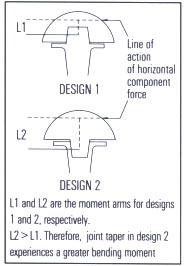
One design theory is that having the male taper on the stem decreases the amount of bending on the taper and decreases the chance of loosening.
Another design uses the taper on the head to make revisions, particularly with the glenoid, easier since the taper isn't poking out of the arm and into the glenoid when the head is removed.
Acumed Polarus Modular Shoulder
 |
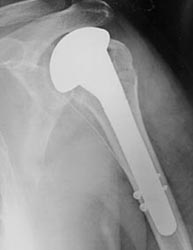 |
|
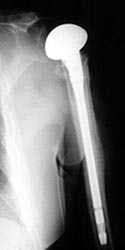 |
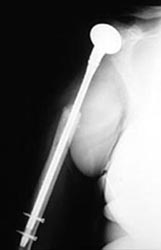 |
Arthrex Univers 3D
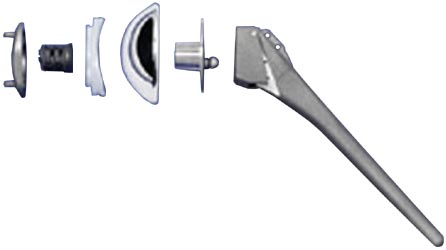 |
 |
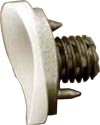 |
| Note adjustable neck angle and two or four dorsal fin configurations |
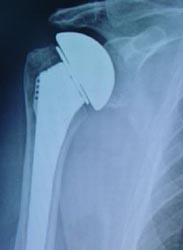 |
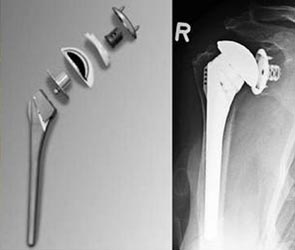 |
January 2002, hemiarthroplasty done at outside institution - Prosthesis not confirmed

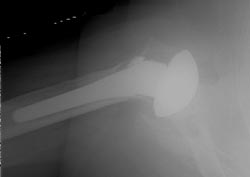
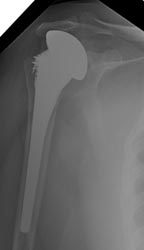
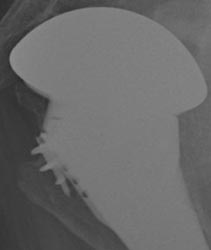
 |
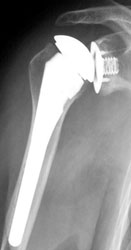 |
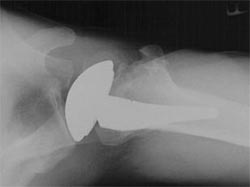 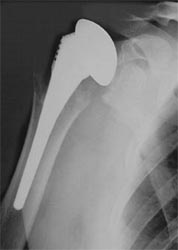 |
| Die verhakte dorsale Schulterluxation |
Arthrex Univers II
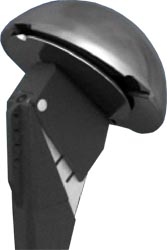 |
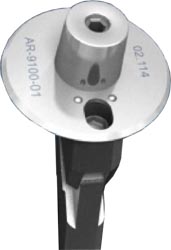 |
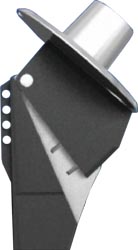 |
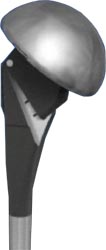 |
| Note adjustable neck angle |
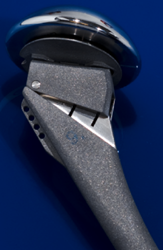
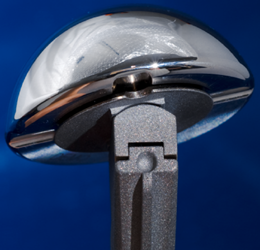

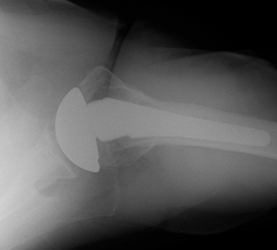
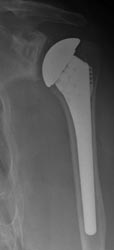
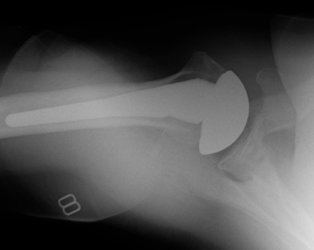
The Arthrex Univers was pulled from the US market due to patent issues but is making a return as the Univers II.
This prosthesis has a hinged neck which is lock in place with and interference friction screw. The extraction tool threads into the neck and relies on the neck to extract the prosthesis. If the neck is damaged and separates from a well fixed prosthesis, removal of the prosthesis will become quit challenging do to lack of protrusions to hit with a bone tamp. Damaging of the prosthesis neck may also prevent you from installing a new head and necessitate splitting of the humerus for prosthetic removal.
Biomet Bio-Modular Choice Shoulder System - See Biomet Prostheses for more images
 |
 |
 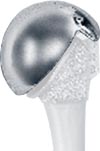 |
  |
| Biomet Bio Modular with Offset Head | Extended Articular Surface Head |
Note distinctive body curve, tapered neck, edge of ingrowth superior stem, and dorsal fin.
This system has a unique extraction tool that fits into the Morse Taper of the humeral component. Use an instrument such as the Kocker clamp to advance the screw into the device so that expands and locks into the hole (finger tightness is not enough). Then attach the Biomet slap hammer and slap away.
The head can be removed with the Biomet pickle which is in a different (humeral head box) box than the stem extractor. The DePuy Pickle fork for the pre Advantage heads seems to also work fine for head separation.
 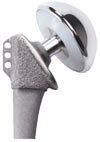 |
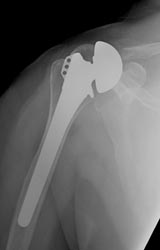 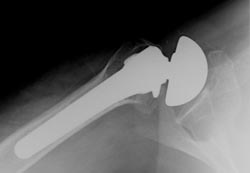 |
| Biomet Modular Bi-Polar Head |
Biomet Integrated Shoulder System - See Biomet Prostheses and Neer Prostheses for more images
 |
 |
 |
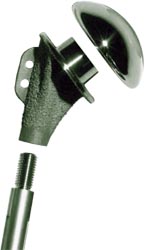 |
 |
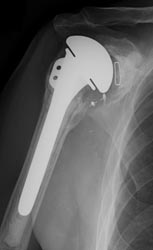 |
| Biomet Integrate Offset Head | Not Confirmed |
 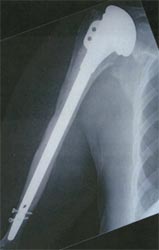 |
| Biomet ATLAS
Treatment of malignant tumors of the proximal humerus with allograft-prosthesis composite reconstruction |
The Biomet Integrated Shoulder System includes the Atlas Modular line as well as the Neer humeral components originally made by Kirschner Medical Corporation which as been bought out by Biomet.
The Neer Prostheses were actually made by several companies and come in different generations
Neer-I humeral heads (Stryker Howmedica)
Neer-II humeral heads (3M)Neer-II total shoulders (3M)
Neer Mark-II prosthesis (3M)
Modular Total Shoulder (3M)
The Neer II (Kirschner) - a monoblock stem.
Kirschner II-C added proximal c porous coating.
Kirschner Modular II-C is identical to Kirschner II-C but with a modular head. These were made by a different company than the 3M Neer prostheses and are not designed to be interchangeable.
Kirschner/Biomet Modular II-CX are still available through Biomet.
Mod II Plus-C (Biomet) -
Atlas (Biomet) - Modular - choices in head thickness, proximal and distal stem diameters, stem lengths and proximal surface finish
Atlas (Biomet) -C - Modular
Neer II - (Smith & Nephew)
Neer 3 - (Smith & Nephew)
Biomet Bi-Angular/Bi-Polar Shoulder System - See Biomet Prostheses for more images
 |
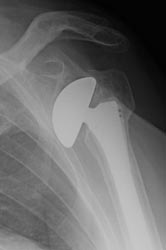 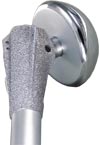 |
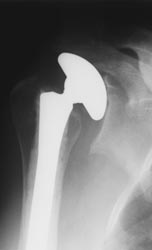 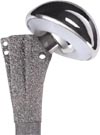 |
| Biomet Bi-Angular | Biomet Bi-Polar |
Note distinctive shape of body with squared off superior edge of humeral stem
Biomet Comprehensive System - See Biomet Prostheses for more images
 |
 |
|
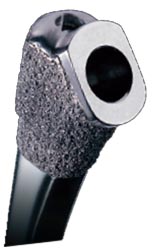 |
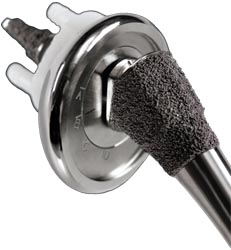 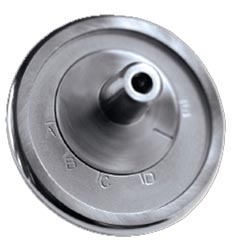 |
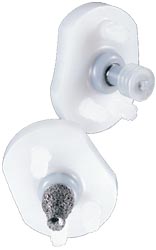 |
| Biomet Comprehensive
Standard Stem |
Mini Stem
|
Revision Length Humeral Stem | Pegged Glenoids with two options for bony ingrowth central peg - also in Keel |
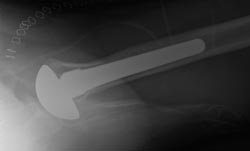
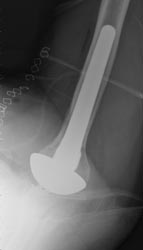
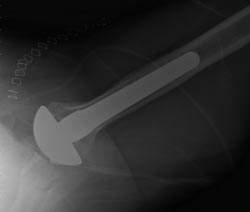
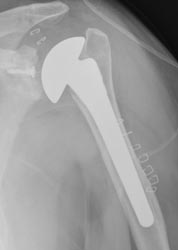
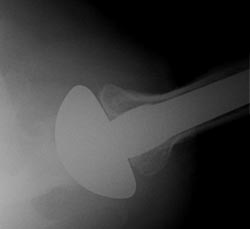
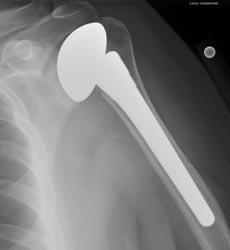
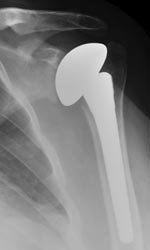
Biomet Comprehensive Fracture System - See Biomet Prostheses for more images
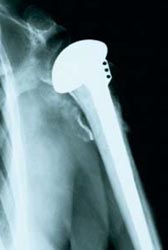  |
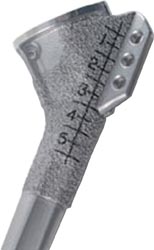 |
| Biomet Comprehensive Fracture Note Double dorsal fines with 3 holes |
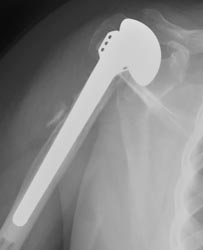
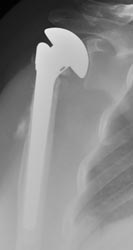
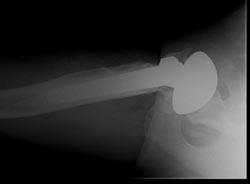
Note oval ventral suture hole which is sometimes present. Some prostheses may have a round ventral suture hole.
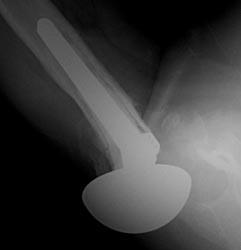
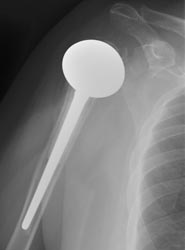
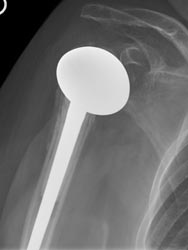
Note oblique dorsal fin with three holes and mid shaft lucency (plastic centering guide)
Biomet Mosaic Humeral Replacement System - See Biomet Prostheses for more images
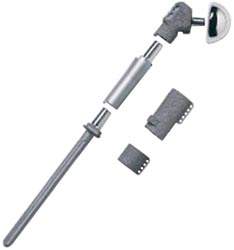 |
|
BioPro
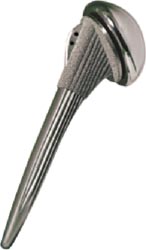
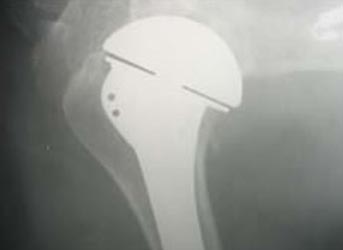
DePuy - See DePuy Prostheses for more images
DePuy had three models - the HRP, Global and Global Advantage
The HRP was a first generation monoblock design
The Global is a second generation Modular Design
The Global Advantage is also a second generation Modular Design
DePuy HRP - See DePuy Prostheses for more images

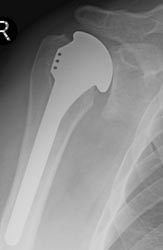
These are monoblock with a dorsal three holed fin. The lack a superior stem rim, space between head and body and ventral fin.
DePuy Global - See DePuy Prostheses for more images



Note space between upper rim of stem and head. Also note how prominent the upper rim is compared to Global Advantage.
Stems also come in bi-sizes and you may see a distinct change in stem diameter mid stem.
This prosthesis uses a "pickle fork" aka "tuning fork" head extractor to separate the head form the stem. This fork is hidden if each of our DePuy set under some of the trays.
DePuy Global Advantage - See DePuy Prostheses for more images
 |
 |
 |
 |
| DePuy Global | Note three holes in dorsal fin. Note hole in anterior fin that is not present with DePuy Global. | Stem is notched in midportion of dorsal fin. You may see the dorsal fin holes recessed slightly into body with a good AP Xray. | The posterior later fins are triangular is shape |
The heads of the Global Advantage obscures the superior rim of the humeral head. This head may also be used on the DePuy Global, making identification difficult.
DePuy Global CTA - See DePuy Prostheses for more images

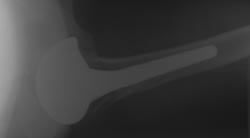
Note distinctive curved back head that overhangs/covers dorsal fin.
DePuy Global Fracture - See DePuy Prostheses for more images
 |
 |
| DePuy Global Fx |
The Depuy Global fracture stems are cobalt steel. It has a more prominent anterior rim than the Global Advantage stem. The dorsal fin has only one hole and the posterior lateral fins have three holes that are positioned more superiorly than the Global Advantage stems. In the fracture stem, the distance of the edge of the first hole from the superior edge of the posterior lateral fin is about the length of the diameter of the hole. The distance from the superior edge to the edge of the first hole in the posterior lateral fin of the Global Advantage is about 3 diameters of one of these holes.
DePuy Global AP - Released February 12, 2007
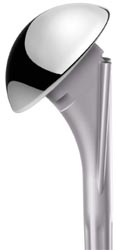 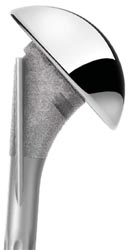 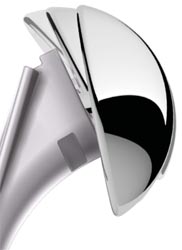 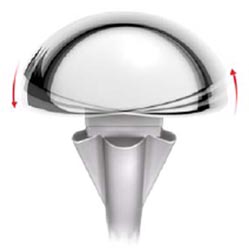 |
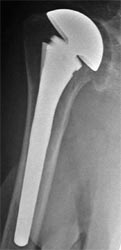 |
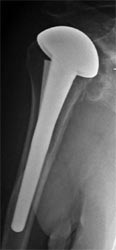 |
Note lack of dorsal fin or holes in side fins. This design allows for adjustment of neck angle in two planes. An adapter is available to allow for fixed angle of the head.
Encore Foundation Total Shoulder System - See Encore Prostheses for more images
  |
 |
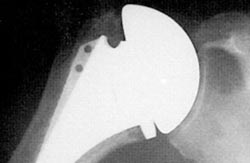 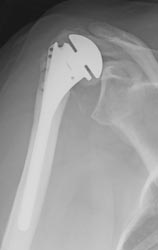 |
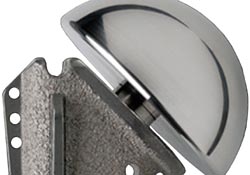 |
|
| Encore Foundation Shoulder | Encore Foundation Fracture
Modular Trial Instrumentation |
Note only two holes? Two holes when the shaft size is10 mm or less. |
Exactech Equinoxe - See Exactech Prostheses for more images
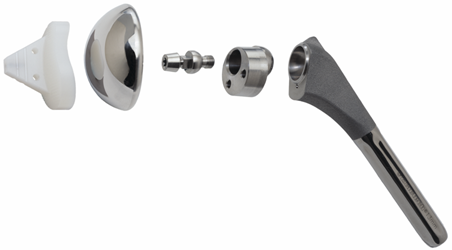 |
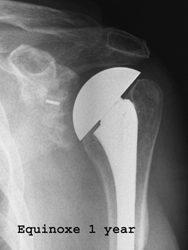 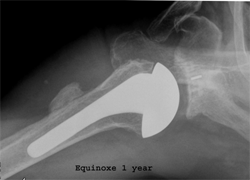 |
|
| No holes in dorsal fin | Note distinctive body shape |
Exactech Equinoxe - See Exactech Prostheses for more images
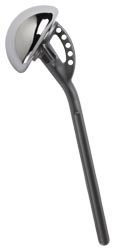 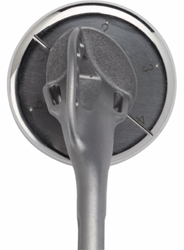 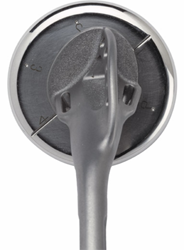 |
 |
| Note open space between dorsal fin and body. |

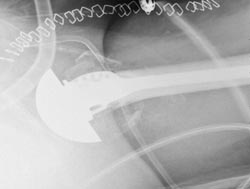
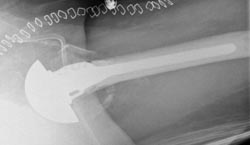
Exactech InterSpace Shoulder Pre-formed Antibiotic Bone Cement Spacer - See Exactech Prostheses for more images
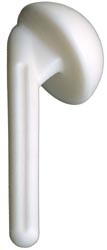 |
 |
|


Neer - See Neer Prostheses for more images
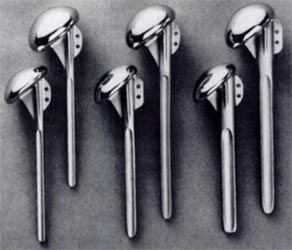 |
 |
| Fins can be rounded or more boxed. | Modular Biomet Neer |
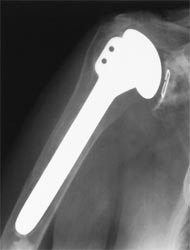 |
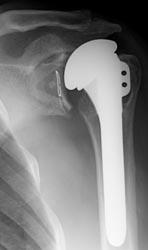 |
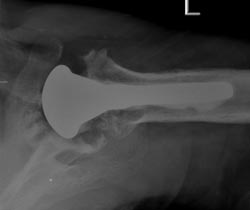 |
| First generation | Second Generation |
Note distinctive dorsal fin with double holes.
The Neer Prostheses were actually made by several companies and come in different generations
Neer-I humeral heads (Stryker Howmedica)
Neer-II humeral heads (3M)Neer-II total shoulders (3M)
Neer Mark-II prosthesis (3M)
Modular Total Shoulder (3M)
The Neer II (Kirschner) - a monoblock stem.
Kirschner II-C added proximal c porous coating.
Kirschner Modular II-C is identical to Kirschner II-C but with a modular head. These were made by a different company than the 3M Neer prostheses and are not designed to be interchangeable.
Kirschner/Biomet Modular II-CX are still available through Biomet.
Mod II Plus-C (Biomet) -
Atlas (Biomet) - Modular - choices in head thickness, proximal and distal stem diameters, stem lengths and proximal surface finish
Atlas (Biomet) -C - Modular
Neer II - (Smith & Nephew)
Neer 3 - (Smith & Nephew)
On xray, the Neer II prostheses are very similar to the monoblock Cofield prostheses. You may be able to differentiate between the two by comparing the inferior edge of the ventral and dorsal fins of the prostheses. The inferior edge of the ventral fin extends below the inferior edge of the dorsal fin of the Neer II components where the edges of these fins are about at the same level (ventral fin actually a tad higher) in the Cofield prostheses.
Smith & Nephew Cofield Total Shoulder System - See Cofield Prostheses for more images
 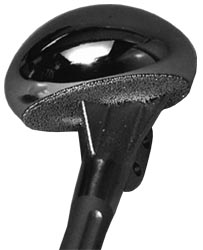 |
 |
|
| Monoblock Cofield 1
Monoblock and modular total shoulder arthroplasty for osteoarthritis |
Thomas H Berquist. Imaging atlas of orthopedic appliances and prostheses. New York : Raven Press, 1995. |
Note Neer-like dorsal fin.
This prosthesis is very similar to the Neer prostheses but the anterior fin's inferior edge is not lower than the inferior edge of the dorsal fin. Note flattened underside of head with sharp edge. Also note pointed tip of stem commonly found on Xryas of Cofield prostheses.
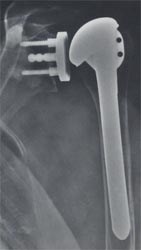
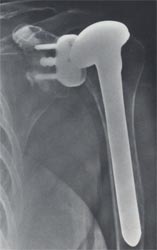
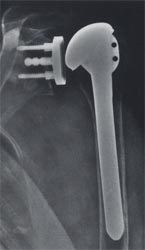
Thomas H Berquist. Imaging atlas of orthopedic appliances and prostheses. New York : Raven Press, 1995.
Smith & Nephew Cofield 2 Total Shoulder System - See Cofield Prostheses for more images
 |
 |
 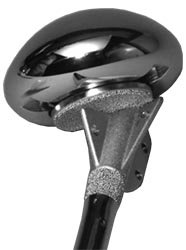 |
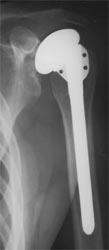 |
| Modular Cofield 2
Monoblock and modular total shoulder arthroplasty for osteoarthritis |
The hole in ventral fin distinguishes the Cofield II it from a Neer or Zimmer BF prosthesis.
Note - hole and fin configurations are very similar to the Zimmer Total Shoulder II monoblock system. The Cofield differs in that it has a pointed distal stem, a ridge/rim under the head and often has a notch/space under the head just superior to dorsal fin. The inferior edge of the ventral fin in the Cofield 2 isn't more inferior than the inferior edge of the dorsal fin as it is in the Zimmer Total Shoulder II. Except for the hole in the ventral find, the Zimmer Total Shoulder 2 has a ventral fin more similar in shape to that of a Neer 2 prosthesis.
Smith & Nephew Neer 3 Total Shoulder System - See Neer Prostheses for more images
 |
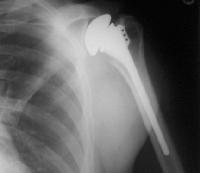 |
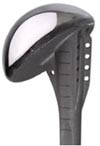 |
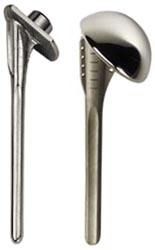 |
 |
|
| Note 4th hole |
Stryker Solar - See Stryker Solar Prostheses for more images
 |
 |
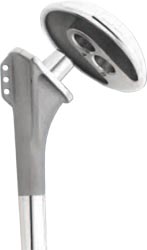 |
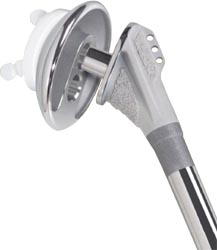 |
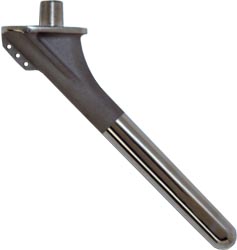 |
| Styker Solar | Note Bony Ingrowth Neck |
Note anterior superior rim, pointy distal end and distinctive heads.
This system has a special extraction device and must be specifically requested from Stryker during any revision case. Without the extraction device, you will need to use a bone tape and a mallet to bang on the rim under the neck to remove the humeral prosthesis.
 |
| Note that Solar Heads are Rounded Off
Blue outlines the profile of many non Stryker designs |
Note distinctive pancaked or large rounded off heads often seen with these systems.
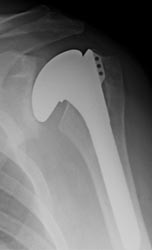 |
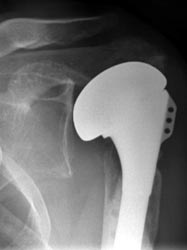 |
|||
| Pancaked eccentric head | Note fat globus (not spherical) head |
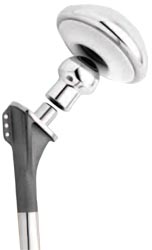 |
 |
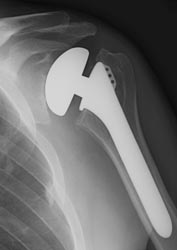 |
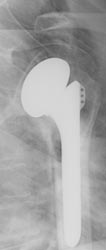 |
| Stryker Bipolar Head |
It can be difficult to differentiate the Biomet Bio-Modular Bipolar from a Stryker Bipolar system. The Stryker may have a pointed distal end and a flat surface at the base of the male Morse taper. The Biomet Bio-Modular should have a tapered up ridge at the base of the female Morse taper and often has a distinctively enlarged neck with a boney ingrowth structure. To make identification more difficult, the bipolar head will often obscure the superior portion of the prosthesis stem and both the Stryker and Biomet components may or may not have enlarged bony ingrowth necks.
Stryker ReUnion Fracture System - See Stryker Solar Prostheses for more images
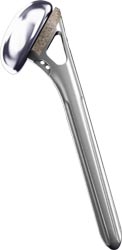 |
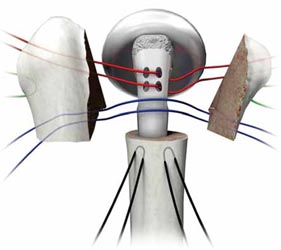 |
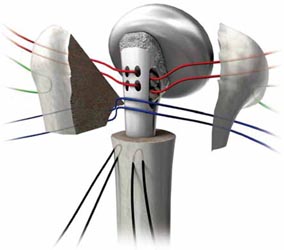 |
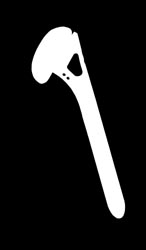 |
|
Note superior medial hole for bone growth.


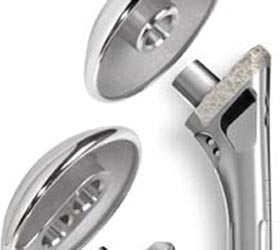

Synthes Epoca
 |
 |
 |
| Titanium stem with titanium plasma coating | Titanium stem with titanium plasma spray and hydroxyapatite coating | CoCr stem |
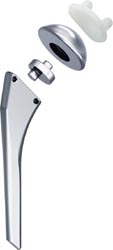
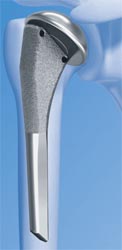

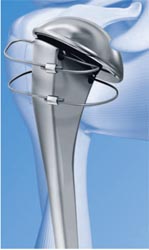

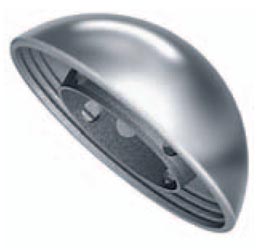

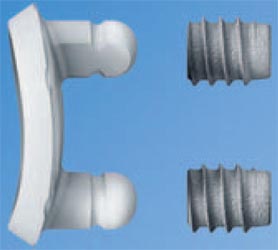

Note angled distal stem and broad proximal neck without fins. The glenoid component has twin pegs. Cement may connect the ends of the two pegs if the peg holes were connected during surgery prior to cementing.
Tornier Aequalis - See Tornier Prostheses for more images
 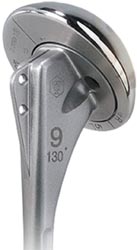 |
 |
 |

|
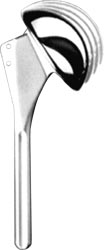 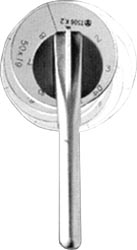 |
| Tornier Aequalis | Cement system | Tornier Press Fit | Variable Fixed Angle Inclination Neck | Adjustability of Tornier System
Arthroscopic Removal of the Glenoid Component for Failed Total Shoulder Arthroplasty |
A screw on the bock of the head (shown above - posterior of stem in left shoulders and anterior in right shoulders) may or may not be used in conjunction with locking of head onto stem. This would make head replacement alone more difficult in a revision surgery and require removal of entire unit, or some fancy drilling or hammering. The screw head accepts a small hex/Allen wrench. The Tornier set has a blue handled driver for this screw. The screw should be removed prior to trying to bang off the head. The head should come off with a bone tamp and a mallet.
The humeral prosthesis can be removed with a medieval appearing adjustable triple claw extractor on slide hammer that comes with the Tornier extractor set. Another removal device in the Tornier revision set is a clamp that hooks under the neck and screws into the Morse taper. This screw in this device can easily become jammed in the extractor during removal of a well cemented prosthesis and will make removal for the extraction device from the prosthesis difficult. You may need to impact the extraction device back unto the prosthesis to unjam the screw on the extraction device or give the extraction device a good wack on the back counter.
Note that Tornier only has a few (three and we broke one) revision extraction sets in the US and plan to request this at least 2 weeks in advance.
Tornier Aequalis (cement version) - See Tornier Prostheses for more images
  |
 |
| Tornier Aequalis | Note distinctive triangular dorsal fin with two holes and medialized eccentric head. |
Tornier Aequalis Press Fit - See Tornier Prostheses for more images
 |
 |
 |
| Tornier Press Fit | Variable Fixed Angle Inclination Neck | Press fit has squared off dorsal fin |
The Tornier Press Fit Shoulder system does not use the screw in the back of the humeral neck to lock the humeral head. You should still have the blue handled screw driver from the Tornier set for peace of mind.
Tornier Aequalis Fracture Shoulder - See Tornier Prostheses for more images
 |
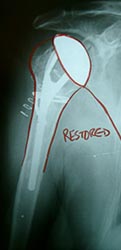 |
  |
 |
| Arthroplasty of the shoulder |
Very distinctive superior medial space to allow for bone growth.
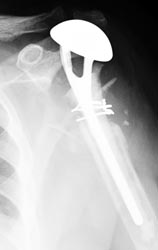
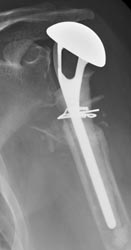
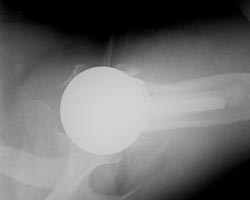
Prosthesis is loose and rotated 180°
Wright Olympia Total Shoulder System
 |
 |
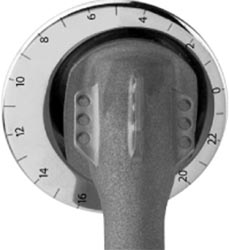 |
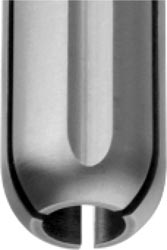 |
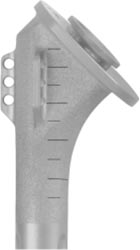 |
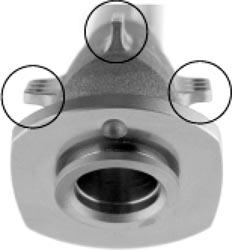 |
|
| Tri-Slot uncemented end
It conforms to the humeral shaft |
Zimmer Bigliani/Flatow - The Complete Shoulder Solution - See Zimmer Prostheses for more images
 |
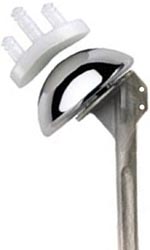 |
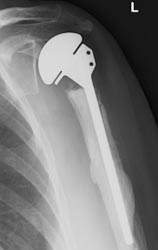 |
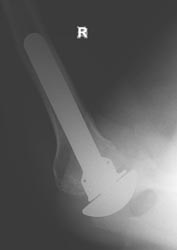 |
| No ventral fin. | Distinct angled off dorsal fin with two holes. | Side fins with single hole |
Zimmer Anatomical - See Zimmer Prostheses for more images
 |
 |
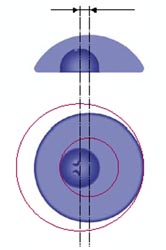 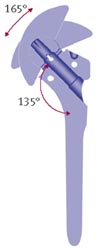  |
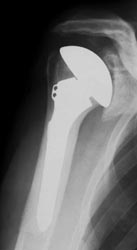 |
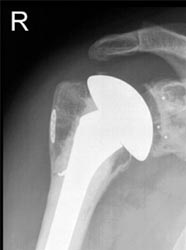 |
| Zimmer Cemented | Zimmer Press Fit | AO/ASIF titanium button-plate on Lesser Tuberosity
Lesser Tuberosity Osteotomy for Total Shoulder Arthroplasty |
Zimmer Anatomical Fracture - See Zimmer Prostheses for more images
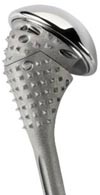  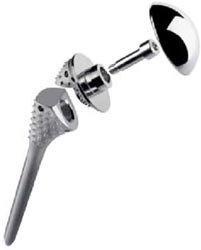 |
| Zimmer Anatomical Fracture |
Zimmer Trabecular Metal - See Zimmer Prostheses for more images
 |
|
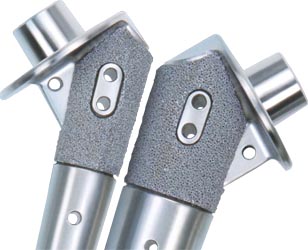 |
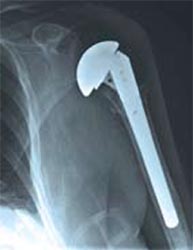 |
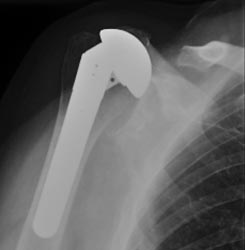
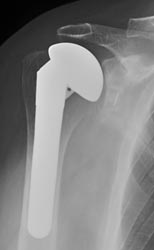
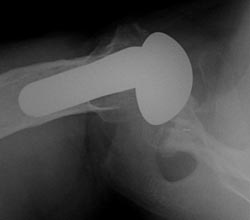
Zimmer Select Shoulder - See Zimmer Prostheses for more images
 |
 |
 |
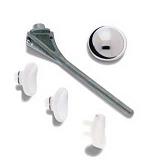 |
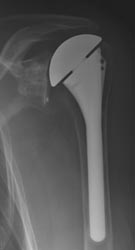 |
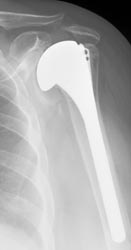
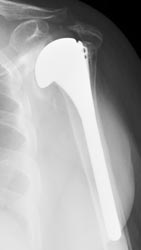
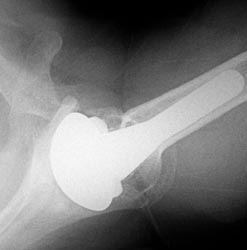
Not confirmed - but done by surgeon that used this prosthesis
Total Shoulder II (Zimmer)
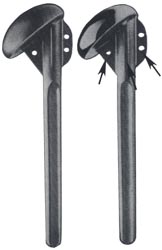
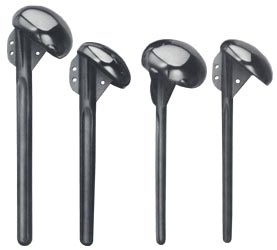
Thomas H Berquist. Imaging atlas of orthopedic appliances and prostheses. New York : Raven Press, 1995.
This is not a prosthesis commonly seen in the revision world in Seattle, but has been added since it can be misidentified as a Cofield 2 prosthesis because of its hole in the ventral fin.
Note monoblock design with dorsal and ventral fins that resemble the Cofield 2 prosthesis. This differs from the Cofield 2 in that it lacks a ridge/rim under the head and the stem tip is rounded off. The inferior edge of the ventral fin is lower than the inferior edge of the dorsal fin of the Zimmer Total Shoulder II.